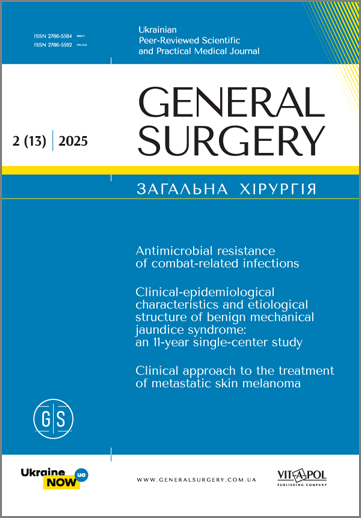Clinical-anamnestic characteristics and quality of life in patients with the Cajal subtype of chronic slow-transit constipation
DOI:
https://doi.org/10.30978/GS-2025-2-44Keywords:
chronic slow transit constipation, Cajal subtype, quality of life, PAC‑QOL scaleAbstract
The Cajal subtype of chronic slow‑transit constipation (CSTC) is associated with Cajal cell deficienсy and is considered the most resistant to conservative therapy. Its diagnosis requires histological analysis of all layers of the intestinal wall, which involves invasiveness and carries the risk of complications. Therefore, the clinical phenotype of this subtype remains insufficiently studied.
Objective – to evaluate the clinical‑anamnestic characteristics and quality of life in patients with the Cajal subtype of chronic slow‑transit constipation following colectomy.
Materials and methods. Over the past 12 years, the Cajal histological subtype of CSTC was diagnosed in 21 patients after colectomy (group O). The comparison group included 70 patients of similar age and sex who did not exhibit signs of CSTC (group R). The study groups did not differ significantly regarding gender, mean age, or body mass index. Clinical‑anamnestic data and quality of life were assessed using the PAC‑QOL scale in both groups.
Results. Women predominated in both groups: 20 (95.2%) in the main group O and 65 (92.9%) in group R. The mean age was 33.9±8.7 years in group O, compared to 41.5 years in group R. The clinical phenotype of patients with the Cajal subtype who required surgical treatment was characterized by early disease onset at a young age (8.67±5.08 years), a high mean disease duration at presentation (25.24±11.18 years; range 3 – 51), and genetic predisposition, with a positive family history in first‑degree relatives in 50.5% of cases. These patients exhibited prolonged intervals between bowel movements (mean 12.2±4.3 days) and lack of response to conservative therapy. Stool types 1 and 2 on the Wexner scale were observed in 71.4% and 28.6% of patients, respectively. Most patients required manual assistance during defecation (95.2%) and experienced pronounced pain syndrome (visual analog scale 2.8±1.3). Quality of life, as measured by the PAC‑QOL scale, showed a significant decline in group O compared to group R across all parameters. Physical discomfort worsened by 2.72 times (3.24±0.44 vs. 1.19±0.29); psychosocial discomfort by 2.19 times (1.84±0.58 vs. 0.84±0.18); anxiety by 2.66 times (2.05±0.24 vs. 0.77±0.24); satisfaction by 2.88 times (2.48±0.59 vs. 0.86±0.28); and the PAC‑QOL score by 2.57 times (2.24±0.25 vs. 0.87±0.12), with p<0.05 for all comparisons.
Conclusions. Our findings confirm the presence of severe clinical and functional disorders in patients with the Cajal subtype, identifying them as potential candidates for surgical treatment.
References
Andrews CN, Storr M. The pathophysiology of chronic constipation. Can J Gastroenterol. 2011 Oct;25 Suppl B(Suppl B):16B-21B. PMID: 22114753; PMCID: PMC3206564.
Andromanakos NP, Pinis SI, Kostakis AI. Chronic severe constipation: current pathophysiological aspects, new diagnostic approaches, and therapeutic options. Eur J Gastroenterol Hepatol. 2015 Mar;27(3):204-14. http://doi.org/10.1097/MEG.0000000000000288. PMID: 25629565.
Aziz I, Whitehead WE, Palsson OS, Törnblom H, Simrén M. An approach to the diagnosis and management of Rome IV functional disorders of chronic constipation. Expert Rev Gastroenterol Hepatol. 2020 Jan;14(1):39-46. http://doi.org/10.1080/17474124.2020.1708718. Epub 2020 Jan 2. PMID: 31893959.
Bharucha AE, Lacy BE. Mechanisms, Evaluation, and management of chronic constipation. Gastroenterology. 2020;158:1232-1249.e3. http://doi.org/10.1053/j.gastro.2019.12.034.
Bharucha AE, Pemberton JH, Locke GR 3rd. American Gastroenterological Association technical review on constipation. Gastroenterology. 2013;144:218-38. http://doi.org/10.1053/j.gastro.2012.10.028.
Black CJ, Ford AC. Chronic idiopathic constipation in adults: epidemiology, pathophysiology, diagnosis and clinical management. Med J Aust. 2018 Jul 16;209(2):86-91. http://doi.org/10.5694/mja18.00241. PMID: 29996755.
Chaichanavichkij P, Vollebregt PF, Tee SZY, Scott SM, Knowles CH. Slow-transit constipation and criteria for colectomy: a cross-sectional study of 1568 patients. BJS Open. 2021 May 7;5(3):zrab049. http://doi.org/10.1093/bjsopen/zrab049. PMID: 34052848; PMCID: PMC8164778.
Deng XM, Zhu TY, Wang GJ, Gao BL, Li RX, Wang JT. Laparoscopic total colectomy with ileorectal anastomosis and subtotal colectomy with antiperistaltic cecorectal anastomosis for slow transit constipation. Updates Surg. 2023 Jun;75(4):871-80. http://doi.org/10.1007/s13304-023-01458-y. Epub 2023 Mar 14. PMID: 36914915.
Feldman M, Friedman LS, Brandt LJ. Sleisenger and Fordtran’s Gastrointestinal and Liver Disease: Pathophysiology, Diagnosis, Management. 11th ed. Elsevier: Philadelphia, PA, USA; 2020.
Huizinga JD, Hussain A, Chen JH. Interstitial cells of Cajal and human colon motility in health and disease. Am J Physiol Gastrointest Liver Physiol. 2021 Nov 1;321(5):G552-G575. http://doi.org/10.1152/ajpgi.00264.2021. Epub 2021 Oct 6. PMID: 34612070.
Knowles CH, Grossi U, Horrocks EJ, Pares D, Vollebregt PF, Chapman M, Brown S, Mercer-Jones M, Williams AB, Yiannakou Y, Hooper RJ, Stevens N, Mason J; NIHR CapaCiTY working group; Pelvic floor Society and; European Society of Coloproctology. Surgery for constipation: systematic review and practice recommendations: Graded practice and future research recommendations. Colorectal Dis. 2017 Sep;19(Suppl 3):101-13. http://doi.org/10.1111/codi.13775. PMID: 28960922.
Leshchyshyn IM, Byk PL, Plodienko MM, Markulan LY, Okhots’ka OI, Martyniuk NS, Dmytriieva KM. Histological changes in the colon wall in adult patients with chronic slow-transit constipation. General Surgery (Ukraine). 2023:(2);16-24. http://doi.org/10.30978/GS-2023-2-16.
Leschyshyn IM, Markulan LY, Okhotska OI, Byk PL, Gonza RV. Clinical and anamnestic characteristics of patients with different subtypes of chronic slow transit constipation. General Surgery (Ukraine). 2025:(1);42-49. http://doi.org/10.30978/GS-2025-1-42.
Marquis P, De La Loge C, Dubois D, McDermott A, Chassany O. Development and validation of the Patient Assessment of Constipation Quality of Life questionnaire. Scand J Gastroenterol. 2005 May;40(5):540-51. http://doi.org/10.1080/00365520510012208. PMID: 16036506.
Peery AF, Crockett SD, Barritt AS, et al. Burden of gastrointestinal, liver, and pancreatic diseases in the United States. Gastroenterology. 2015;149:1731-41.e3. http://doi.org/10.1053/j.gastro.2015.08.045.
Suares NC, Ford AC. Prevalence of, and risk factors for, chronic idiopathic constipation in the community: systematic review and meta-analysis. Am J Gastroenterol. 2011 Sep;106(9):1582-91; quiz 1581, 1592. http://doi.org/10.1038/ajg.2011.164. Epub 2011 May 24. PMID: 21606976.
Tian Y, Wang L, Ye JW, et al. Defecation function and quality of life in patients with slow-transit constipation after colectomy. World J Clin Cases. 2020 May 26;8(10):1897-907. http://doi.org/10.12998/wjcc.v8.i10.1897. PMID: 32518779; PMCID: PMC7262699.
Vlismas LJ, Wu W, Ho V. Idiopathic slow transit constipation: pathophysiology, diagnosis, and management. Medicina (Kaunas). 2024 Jan 6;60(1):108. http://doi.org/10.3390/medicina60010108. PMID: 38256369; PMCID: PMC10819559.
Downloads
Published
How to Cite
Issue
Section
License
Copyright (c) 2025 Authors

This work is licensed under a Creative Commons Attribution-NoDerivatives 4.0 International License.






